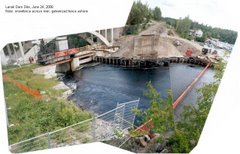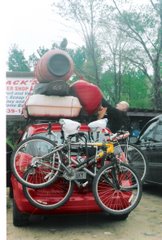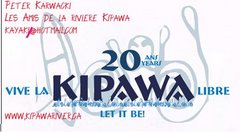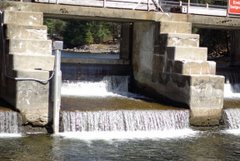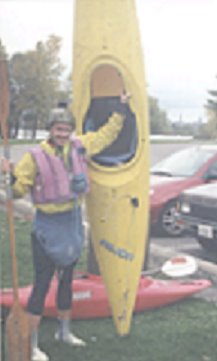Saturday, December 3, 2011
A financial system that is in worse shape than ever
Ilargi - the automaticearth.blogspot.com
if we keep on spending ever more trillions to prevent Armageddon from arriving, surely we must invite it, by the very act of doing exactly that, to at some point come knocking on the back door. After all, you can't spend more and more, and then some, without ever being served with the bill for doing so.
So we’ve had all these rescue missions over the past 5 years. Behemoth-sized amounts of taxpayer money and future taxpayer money have been poured into our economies in this alleged attempt to try and save them.
Now, take a step back and tell me what you see. I'll tell you what I see: a financial system that is in worse shape than ever before during those 5 years. At least half of Europe is flat broke, most banks have lost 50%-80% of their market value, Bank of America, a major bailout recipient, is fast on its way to becoming a penny stock, China sees shrinkage wherever it looks and Japan is rumored to be awkwardly close to the chopping block.
...
We have a choice to make: either we save the banks, or we save our societies. Which are falling apart as we speak on account of the costs of saving an already deeply bankrupt financial system.
But we're not even starting to discuss that choice. All choices and decisions are being made -for us- in a one-dimensional vacuum theater by a small group of people who, to a (wo)man, flatly deny that such a choice needs to be made or even exists. Because making that choice doesn't fit their purposes and careers and fortunes and ego's.
Merkel, Blankfein, Sarkozy, Jamie Dimon, Obama, David Cameron, Mario Draghi and Timothy Geithner, they are all servants of the existing financial system, of the existing banks, which are broke but try to hide that from us. At our debilitating expense.
Yes, they've been able to stave off the inevitable until now. But that has only been possible because they have virtually unlimited access to your money, to the wallets of the 99%.
We should grow up and make these decisions ourselves, instead of letting a group of morally severely challenged suits with very vested interests make them for us any longer.
They're leading us straight into Dante’s Ninth Circle of Hell. And last I heard, that's definitely not a place to raise your kids.
Friday, December 2, 2011
unwinding - what does it mean?
John Glover of Bloomberg (as cited on theautomaticearth.blogspot.com) said
What the inflationistas are missing is that Europe is actually suffering from a profound contraction of its money supply. This contraction is crippling the banking system and will bring the economy to a grinding halt if it is not allieviated.
It’s easy to miss the contraction of the money supply because it involves a destruction of financial assets that we do not usually think of as “money” but that, in fact, operate as money — or did until relatively recently.
What the inflationistas are missing is that Europe is actually suffering from a profound contraction of its money supply. This contraction is crippling the banking system and will bring the economy to a grinding halt if it is not allieviated.
It’s easy to miss the contraction of the money supply because it involves a destruction of financial assets that we do not usually think of as “money” but that, in fact, operate as money — or did until relatively recently.
Thursday, December 1, 2011
Moral Hazard? You May have heard this term - do you know what it is?
Moral Hazard - would you do the right thing?
This is in reference to bankers. If they make risky inappropriate bets and especially are they are considered to big to fail, then the government will rush in to save them if they become insolvent.
But if their risky bets work out, they consider themselves heroes, pay themselves and their shareholders big bonuses.
So there is no downside to their mistakes and total upside for their wins.
There is no difference between what is right and what is wrong - a free for all.
This is complicated by the interweaving of government and corporations, especially banks and the military industrial complex. Often senior bureaucrats and politicians end up working within the government and then for the corporations, backslapping and congratulating themselves every step of the way.
Naturally this can go on for quite a while - until the whole thing unwinds.
God bless America.
This is in reference to bankers. If they make risky inappropriate bets and especially are they are considered to big to fail, then the government will rush in to save them if they become insolvent.
But if their risky bets work out, they consider themselves heroes, pay themselves and their shareholders big bonuses.
So there is no downside to their mistakes and total upside for their wins.
There is no difference between what is right and what is wrong - a free for all.
This is complicated by the interweaving of government and corporations, especially banks and the military industrial complex. Often senior bureaucrats and politicians end up working within the government and then for the corporations, backslapping and congratulating themselves every step of the way.
Naturally this can go on for quite a while - until the whole thing unwinds.
God bless America.
Wednesday, November 30, 2011
CBC's Neil MacDonald Nails it Again
There is a pattern here: Small-time losers, and even a few of the meltdown's medium-size culprits, go to prison. The really big boys and girls, meanwhile, hide behind corporate anonymity, perhaps pay fines, and admit no wrongdoing.
The full story
In the United States - Justic is not blind... the big fish are being let go, and the poor schmucks are getting pasted.
There is now a glimmer of hope:
District Court Judge Jed S. Rakoff rejected a, yet another, admit-no-wrongdoing SEC settlement, this one with Citigroup.
One of the largest banks in the world, Citigroup had, back in 2007, created a $1-billion mortgage fund filled with securities that, according to the SEC, it knew would fail.
The banking giant then placed bets against customers who bought these funds, so as to profit from their losses, which turned out to be another common practice during the subprime meltdown.
The full story
In the United States - Justic is not blind... the big fish are being let go, and the poor schmucks are getting pasted.
There is now a glimmer of hope:
District Court Judge Jed S. Rakoff rejected a, yet another, admit-no-wrongdoing SEC settlement, this one with Citigroup.
One of the largest banks in the world, Citigroup had, back in 2007, created a $1-billion mortgage fund filled with securities that, according to the SEC, it knew would fail.
The banking giant then placed bets against customers who bought these funds, so as to profit from their losses, which turned out to be another common practice during the subprime meltdown.
Tuesday, November 29, 2011
CEAA Review abruptly cancelled by committee
Parliamentary Review of Canadian Environmental Assessment Act Abruptly Terminated
read about it **********Have a Nice Day**********
I just spoke to a colleague that said the occupy movement was wrong headed. To protest, you take your sign over to parliament hill and stand there, you don't camp out etc.
I said democracy was messy.
He said if he went to a park and camped out he'd be arrested in short order.
I asked him when it was the last time he knew that any protest had ever been successful?
He suggested some senator went on a hunger strike to save Katimavik.
Where are we going in this country? Brigitte Depape was right! Stop Harper.
Hill Times
House Environment Committee winds down review of Environmental Assessment Act
NDP Environment Critic calls exercise a farce,' accuses government of already drafting legislative overhaul of EA process.
Chris Plecash
The House Environment Committee is winding down its statutory review of the Canadian Environmental Assessment Act, a process that committee vice-chair and NDP environment critic Megan Leslie is calling a farce, accusing the government of already drafting legislation to overhaul the federal environmental assessment process.
The Canadian Environmental Assessment Act, which sets out the criteria and processes to assess the environmental impacts of development that receives federal approval, was amended in 2003 to require a committee review of the legislation on a seven-year basis.
Since beginning its review of CEAA on Oct. 20, the Committee on the Environment and Sustainable Development has heard from a range of stakeholders on the need to amend the regulatory framework, including Canadian Environmental Assessment Agency president Elaine Feldman, and representatives from a range of industry, environmental, and aboriginal groups, including the Canadian Association of Petroleum Producers, Ecojustice, and the Assembly of First Nations.
After nine two-hour meetings on the merits and shortfalls of CEAA, the committee is at the conclusion of the review process. The time constraints on the review process have led Ms. Leslie to question the usefulness of the hearings.
We have these witnesses crammed on the witness list where they speak for ten minutes, we have a couple of rounds of questions, and everybody goes home, observed Ms. Leslie, who vice-chairs the committee with Liberal environment critic Christie Duncan (Etobicoke North, Ont.), and Conservative MP and committee chair Mark Warawa (Langley, B.C.).
I believe the government is already working on the act and what we're doing in the committee is not going to have any impact on what we see, Ms. Leslie added. The government isn't questioning environmental groups, they're only questioning industry. They aren't questioning native groups, they're only questioning industry.
The disparity between the number of questions that government MPs have asked of industry associations and the number of questions that have been asked of public interest groups has been noticeable throughout the review of the CEAA.
When Sierra Club of Canada executive director John Bennett appeared before the committee on Nov. 1, he used part of his opening statement to describe efforts to streamline environmental regulation through funding cuts as part of a wider anti-democratic campaign to marginalize and eventually silence the voices of the environment in Canada, but not before Conservative MP Michelle Rempel (Calgary Centre-North, Alta.) raised a point of order that Mr. Bennett's comments were rhetoric-driven.
We're interested in hearing fact-based testimony today, and we'd encourage the witness to do so as well, Ms. Rempel reminded Mr. Bennett.
In his statement, Mr. Bennett highlighted the lack of public input into CEAA's review, pointing out that his appearance came on the heels of the federal government's decision in late October to end its funding to the Canadian Environmental Network.
There has not been consultation with the stakeholders this time, Mr. Bennett told the committee. The decision to stop consulting environmental organizations and withdraw support for the CEN at precisely the time CEAA is being reviewed clearly is no coincidence. It sends a clear signal.
Conservative MPs did take the opportunity to question the Sierra Club's executive director on how CEAA could be improved, but the majority of questions from the government side of the committee were directed to representatives of the Canadian Water & Wastewater Association and the Canadian Electricity Association, who stressed the need for simplifying the environmental assessment process by eliminating the duplication of assessment steps by the federal government and the provinces.
There was a similar disparity between questions posed by government members to industry and those posed to public interest groups when representatives for the Assembly of First Nations appeared before the committee on Nov. 17.
Let the AFN be very clear, First Nations are not opposed to development, AFN strategist Roger Jones declared in his opening remarks to the committee. In these cases, First Nations have already determined that development is entirely consistent with our obligations to the Earth and to our peoples.
Mr. Jones went on to call for a more inclusive environmental assessment process that worked to reconcile First Nations' rights with industry interests, including the establishment of a Crown-First Nations process to reform CEAA.
The time and resources it takes to do so should be seen as an investment to get it right for all actors, rather than simply an exercise in First Nation engagement, said Mr. Jones.
The two-hour long hearings on Nov. 17 were shared between representatives of the Assembly of First Nations, the Canadian Association of Petroleum Producers, the Mining Association of Canada, and the James Bay Advisory Committee on the Environment.
AFN's strongly worded opening statement was overshadowed by the presence of associations representing two of Canada's largest industries. The overwhelming majority of questions from Conservative MPs were directed towards CAPP and MAC, while Liberal and NDP MPs the bulk of their questions towards AFN and the James Bay Advisory Committee.
However, Conservative MP and committee member James Lunney (Nanaimo-Alberni, B.C.) took exception to the suggestion that committee members from his party were only interested in hearing from industry.
I directed questions myself to AFN and to the James Bay Council, Mr. Lunney pointed out. I think that it's unfair to say that we have not engaged with other people at the table.
Mr. Lunney specifically asked the James Bay Advisory committee for examples of mining projects that had brought development and employment to their region. He also asked the Assembly of First Nations how the controversial Prosperity Mine project on B.C.'s Fish Lake could gain the support of the area's First Nations.
If we start with no' as a beginning, how do we resolve issues like that, and is there a process? Is there going to be any hope of resolving this through process, without going to the Supreme Court, Mr. Lunney asked the AFN representatives.
[S]ometimes you have to look at it more broadly, Mr. Jones responded. That means you have to look at alternative options in terms of what is potentially available by way of economic development in that area. Is that the only one, or are there others that may in fact serve the needs and interests of everyone in that area?
The Taseko Mines Ltd. gold and copper mining project failed to pass a federal environmental assessment under former Environment Minister Jim Prentice last November, despite having passed a provincial environmental assessment by the B.C. government. Earlier this month the company submitted a new plan to CEAA that would spare Fish Lake from mine tailings, but the area's First Nations continue to oppose the project.
Mr. Lunney also defended the current committee review process for CEAA.
It's all about balance, but it's a balance and people are coming around to the perspective that socio-economic values should be considered as well, he told The Hill Times. There has got to be better ways to coordinate a response so that we can accomplish what we're setting out to do in terms of environmental protection and still not impair economic development and job creation.
A number of issues with CEAA have emerged throughout the hearings. The act currently uses a trigger process to determine whether or not a project is subject to a federal environmental assessment. In CEAA's present form, a project triggers an assessment if the federal government is the proponent of that project, or if the project receives some form of federal funding or assistance, utilizes federal land, or requires federal licences or permits. Under this criteria, installing a bench in a National Park requires some form of environmental assessment.
In Oct. 25 testimony Vancouver-based environmental lawyer Paul Cassidy suggested eliminating the trigger process for environmental assessments, replacing it with a defined list that bases assessments on the anticipated environmental impacts of a given project. Others have warned that such a framework would be unable to keep up with forms of development that have yet to come into existence.
Another issue that has dominated the hearings is the jurisdictional overlap between provincial and federal environmental assessments. The addition of a federal environmental assessment can add years to a project's approval process.
In his Nov. 22 testimony, Saskatchewan Assistant Deputy Minister of Environment Mark Wittrup argued for a one project, one assessment approach to environmental assessments.
Saskatchewan supports a vision that would redefine federal and provincial responsibilities in order to endow Canada with a system based upon a principle of one project, one assessment, Mr. Wittrup told the committee. Saskatchewan recommends CEAA acknowledge provincial environmental assessments as equivalent to a federal environmental assessment for all projects on provincial lands.
While government members of the committee have focused their questions on how CEAA could be reformed to eliminate duplication between federal and provincial assessments and reduce assessment timelines, opposition members have focused on how CEAA can be made to improve public input into the process.
If you watch the Conservatives, they are mimicking the exact language of the Environment minister about streamlining assessments for big energy projects, Ms. Leslie told The Hill Times. All the questions are directed to industry, and it's basically So, what do you want us to do?'
In their 2011 election platform, the Conservatives promised to streamline the regulatory approval process for mining and energy projects, which could signal significant changes to how the federal government assesses future development.
Green Party Leader Elizabeth May (Saanich-Gulf Islands, B.C.), who has followed the committee hearings closely, said that CEAA has been unfairly demonized by the government.
The environmental assessment process is ideally a planning tool to get better projects at the end of the day, said Ms. May, who has been. The Conservative members are so misunderstanding the process that they're treating it as though it's the enemy, it's red light/green light and they don't want it. So they're undermining the environmental assessment process.
Ms. May submitted a request to appear before the committee to discuss CEAA, but she is unlikely to receive an invitation. Committee chair and Conservative MP Mark Warawa (Langley, B.C.) told The Hill Times that he expected the CEAA hearings to wrap up by Nov. 24.
Last week the Conservative members of the committee also voted to go in camera following Ms. Leslie's motion to have Environment Minister Peter Kent (Thornhill, Ont.) appear to review his department's supplementary estimates prior to their Dec. 10 approval.
Obviously I can't tell you what happened in that meeting but I suspect that if you check the agenda for the coming week you're probably not going to see the Minister on it, Ms. Leslie said following the Nov. 22 meeting.
Mr. Lunney said that the committee had an obligation to review the supplementary estimates, but Mr. Kent's appearance depended on scheduling. Ms. Leslie had moved to have the Environment Minister appear no later than Nov. 29.
I think that some of the members are perhaps adjusting to the new reality of a majority, said Mr. Lunney. What we had in the last five years was not normal Parliamentary function, so there are some adjustments on the opposition side. When we were in opposition, when push came to shove we knew we might lose a vote, but in the meantime we tried to collaborate, communicate and do what we could to influence the agenda.
The Players:
Mark Warawa Mark.Warawa@parl.gc.ca>
Megan Leslie Megan.Leslie@parl.gc.ca> - NDP
Kirsty Duncan Kirsty.Duncan@parl.gc.ca>
Stella Ambler Stella.Ambler@parl.gc.ca>
Bruce Hyer Bruce.Hyer@parl.gc.ca>
Laurin Liu Laurin.Liu@parl.gc.ca>
Lise St-Denis Lise.St-Denis@parl.gc.ca>
James Lunney Lunney.J@parl.gc.ca>
Michelle Rempel Michelle.Rempel@parl.gc.ca>
Robert Sopuck Robert.Sopuck@parl.gc.ca>
Lawrence Toet Lawrence.Toet@parl.gc.ca>
Stephen Woodworth Stephen.Woodworth@parl.gc.ca>
Marie-France Renaud ENVI@parl.gc.ca>
read about it **********Have a Nice Day**********
I just spoke to a colleague that said the occupy movement was wrong headed. To protest, you take your sign over to parliament hill and stand there, you don't camp out etc.
I said democracy was messy.
He said if he went to a park and camped out he'd be arrested in short order.
I asked him when it was the last time he knew that any protest had ever been successful?
He suggested some senator went on a hunger strike to save Katimavik.
Where are we going in this country? Brigitte Depape was right! Stop Harper.
Hill Times
House Environment Committee winds down review of Environmental Assessment Act
NDP Environment Critic calls exercise a farce,' accuses government of already drafting legislative overhaul of EA process.
Chris Plecash
The House Environment Committee is winding down its statutory review of the Canadian Environmental Assessment Act, a process that committee vice-chair and NDP environment critic Megan Leslie is calling a farce, accusing the government of already drafting legislation to overhaul the federal environmental assessment process.
The Canadian Environmental Assessment Act, which sets out the criteria and processes to assess the environmental impacts of development that receives federal approval, was amended in 2003 to require a committee review of the legislation on a seven-year basis.
Since beginning its review of CEAA on Oct. 20, the Committee on the Environment and Sustainable Development has heard from a range of stakeholders on the need to amend the regulatory framework, including Canadian Environmental Assessment Agency president Elaine Feldman, and representatives from a range of industry, environmental, and aboriginal groups, including the Canadian Association of Petroleum Producers, Ecojustice, and the Assembly of First Nations.
After nine two-hour meetings on the merits and shortfalls of CEAA, the committee is at the conclusion of the review process. The time constraints on the review process have led Ms. Leslie to question the usefulness of the hearings.
We have these witnesses crammed on the witness list where they speak for ten minutes, we have a couple of rounds of questions, and everybody goes home, observed Ms. Leslie, who vice-chairs the committee with Liberal environment critic Christie Duncan (Etobicoke North, Ont.), and Conservative MP and committee chair Mark Warawa (Langley, B.C.).
I believe the government is already working on the act and what we're doing in the committee is not going to have any impact on what we see, Ms. Leslie added. The government isn't questioning environmental groups, they're only questioning industry. They aren't questioning native groups, they're only questioning industry.
The disparity between the number of questions that government MPs have asked of industry associations and the number of questions that have been asked of public interest groups has been noticeable throughout the review of the CEAA.
When Sierra Club of Canada executive director John Bennett appeared before the committee on Nov. 1, he used part of his opening statement to describe efforts to streamline environmental regulation through funding cuts as part of a wider anti-democratic campaign to marginalize and eventually silence the voices of the environment in Canada, but not before Conservative MP Michelle Rempel (Calgary Centre-North, Alta.) raised a point of order that Mr. Bennett's comments were rhetoric-driven.
We're interested in hearing fact-based testimony today, and we'd encourage the witness to do so as well, Ms. Rempel reminded Mr. Bennett.
In his statement, Mr. Bennett highlighted the lack of public input into CEAA's review, pointing out that his appearance came on the heels of the federal government's decision in late October to end its funding to the Canadian Environmental Network.
There has not been consultation with the stakeholders this time, Mr. Bennett told the committee. The decision to stop consulting environmental organizations and withdraw support for the CEN at precisely the time CEAA is being reviewed clearly is no coincidence. It sends a clear signal.
Conservative MPs did take the opportunity to question the Sierra Club's executive director on how CEAA could be improved, but the majority of questions from the government side of the committee were directed to representatives of the Canadian Water & Wastewater Association and the Canadian Electricity Association, who stressed the need for simplifying the environmental assessment process by eliminating the duplication of assessment steps by the federal government and the provinces.
There was a similar disparity between questions posed by government members to industry and those posed to public interest groups when representatives for the Assembly of First Nations appeared before the committee on Nov. 17.
Let the AFN be very clear, First Nations are not opposed to development, AFN strategist Roger Jones declared in his opening remarks to the committee. In these cases, First Nations have already determined that development is entirely consistent with our obligations to the Earth and to our peoples.
Mr. Jones went on to call for a more inclusive environmental assessment process that worked to reconcile First Nations' rights with industry interests, including the establishment of a Crown-First Nations process to reform CEAA.
The time and resources it takes to do so should be seen as an investment to get it right for all actors, rather than simply an exercise in First Nation engagement, said Mr. Jones.
The two-hour long hearings on Nov. 17 were shared between representatives of the Assembly of First Nations, the Canadian Association of Petroleum Producers, the Mining Association of Canada, and the James Bay Advisory Committee on the Environment.
AFN's strongly worded opening statement was overshadowed by the presence of associations representing two of Canada's largest industries. The overwhelming majority of questions from Conservative MPs were directed towards CAPP and MAC, while Liberal and NDP MPs the bulk of their questions towards AFN and the James Bay Advisory Committee.
However, Conservative MP and committee member James Lunney (Nanaimo-Alberni, B.C.) took exception to the suggestion that committee members from his party were only interested in hearing from industry.
I directed questions myself to AFN and to the James Bay Council, Mr. Lunney pointed out. I think that it's unfair to say that we have not engaged with other people at the table.
Mr. Lunney specifically asked the James Bay Advisory committee for examples of mining projects that had brought development and employment to their region. He also asked the Assembly of First Nations how the controversial Prosperity Mine project on B.C.'s Fish Lake could gain the support of the area's First Nations.
If we start with no' as a beginning, how do we resolve issues like that, and is there a process? Is there going to be any hope of resolving this through process, without going to the Supreme Court, Mr. Lunney asked the AFN representatives.
[S]ometimes you have to look at it more broadly, Mr. Jones responded. That means you have to look at alternative options in terms of what is potentially available by way of economic development in that area. Is that the only one, or are there others that may in fact serve the needs and interests of everyone in that area?
The Taseko Mines Ltd. gold and copper mining project failed to pass a federal environmental assessment under former Environment Minister Jim Prentice last November, despite having passed a provincial environmental assessment by the B.C. government. Earlier this month the company submitted a new plan to CEAA that would spare Fish Lake from mine tailings, but the area's First Nations continue to oppose the project.
Mr. Lunney also defended the current committee review process for CEAA.
It's all about balance, but it's a balance and people are coming around to the perspective that socio-economic values should be considered as well, he told The Hill Times. There has got to be better ways to coordinate a response so that we can accomplish what we're setting out to do in terms of environmental protection and still not impair economic development and job creation.
A number of issues with CEAA have emerged throughout the hearings. The act currently uses a trigger process to determine whether or not a project is subject to a federal environmental assessment. In CEAA's present form, a project triggers an assessment if the federal government is the proponent of that project, or if the project receives some form of federal funding or assistance, utilizes federal land, or requires federal licences or permits. Under this criteria, installing a bench in a National Park requires some form of environmental assessment.
In Oct. 25 testimony Vancouver-based environmental lawyer Paul Cassidy suggested eliminating the trigger process for environmental assessments, replacing it with a defined list that bases assessments on the anticipated environmental impacts of a given project. Others have warned that such a framework would be unable to keep up with forms of development that have yet to come into existence.
Another issue that has dominated the hearings is the jurisdictional overlap between provincial and federal environmental assessments. The addition of a federal environmental assessment can add years to a project's approval process.
In his Nov. 22 testimony, Saskatchewan Assistant Deputy Minister of Environment Mark Wittrup argued for a one project, one assessment approach to environmental assessments.
Saskatchewan supports a vision that would redefine federal and provincial responsibilities in order to endow Canada with a system based upon a principle of one project, one assessment, Mr. Wittrup told the committee. Saskatchewan recommends CEAA acknowledge provincial environmental assessments as equivalent to a federal environmental assessment for all projects on provincial lands.
While government members of the committee have focused their questions on how CEAA could be reformed to eliminate duplication between federal and provincial assessments and reduce assessment timelines, opposition members have focused on how CEAA can be made to improve public input into the process.
If you watch the Conservatives, they are mimicking the exact language of the Environment minister about streamlining assessments for big energy projects, Ms. Leslie told The Hill Times. All the questions are directed to industry, and it's basically So, what do you want us to do?'
In their 2011 election platform, the Conservatives promised to streamline the regulatory approval process for mining and energy projects, which could signal significant changes to how the federal government assesses future development.
Green Party Leader Elizabeth May (Saanich-Gulf Islands, B.C.), who has followed the committee hearings closely, said that CEAA has been unfairly demonized by the government.
The environmental assessment process is ideally a planning tool to get better projects at the end of the day, said Ms. May, who has been. The Conservative members are so misunderstanding the process that they're treating it as though it's the enemy, it's red light/green light and they don't want it. So they're undermining the environmental assessment process.
Ms. May submitted a request to appear before the committee to discuss CEAA, but she is unlikely to receive an invitation. Committee chair and Conservative MP Mark Warawa (Langley, B.C.) told The Hill Times that he expected the CEAA hearings to wrap up by Nov. 24.
Last week the Conservative members of the committee also voted to go in camera following Ms. Leslie's motion to have Environment Minister Peter Kent (Thornhill, Ont.) appear to review his department's supplementary estimates prior to their Dec. 10 approval.
Obviously I can't tell you what happened in that meeting but I suspect that if you check the agenda for the coming week you're probably not going to see the Minister on it, Ms. Leslie said following the Nov. 22 meeting.
Mr. Lunney said that the committee had an obligation to review the supplementary estimates, but Mr. Kent's appearance depended on scheduling. Ms. Leslie had moved to have the Environment Minister appear no later than Nov. 29.
I think that some of the members are perhaps adjusting to the new reality of a majority, said Mr. Lunney. What we had in the last five years was not normal Parliamentary function, so there are some adjustments on the opposition side. When we were in opposition, when push came to shove we knew we might lose a vote, but in the meantime we tried to collaborate, communicate and do what we could to influence the agenda.
The Players:
Mark Warawa Mark.Warawa@parl.gc.ca>
Megan Leslie Megan.Leslie@parl.gc.ca> - NDP
Kirsty Duncan Kirsty.Duncan@parl.gc.ca>
Stella Ambler Stella.Ambler@parl.gc.ca>
Bruce Hyer Bruce.Hyer@parl.gc.ca>
Laurin Liu Laurin.Liu@parl.gc.ca>
Lise St-Denis Lise.St-Denis@parl.gc.ca>
James Lunney Lunney.J@parl.gc.ca>
Michelle Rempel Michelle.Rempel@parl.gc.ca>
Robert Sopuck Robert.Sopuck@parl.gc.ca>
Lawrence Toet Lawrence.Toet@parl.gc.ca>
Stephen Woodworth Stephen.Woodworth@parl.gc.ca>
Marie-France Renaud ENVI@parl.gc.ca>
Monday, November 28, 2011
WHAT DID OCCUPY WALLSTREET ETC REALLY WANT?
No 1 agenda item: get the money out of politics. Prevent boundless sums enter the campaign process.
No 2: reform the banking system to prevent fraud and manipulation, with the most frequent item being to restore the Glass-Steagall Act – the Depression-era law, done away with by President Clinton, that separates investment banks from commercial banks. This law would correct the conditions for the recent crisis, as investment banks could not take risks for profit that create kale derivatives out of thin air, and wipe out the commercial and savings banks.
No 3: draft laws against the little-known loophole that currently allows members of Congress to pass legislation affecting Delaware-based corporations in which they themselves are investors.
Naomi Wolf
guardian.co.uk, Friday 25 November 2011 12.25 EST
Article history
No 2: reform the banking system to prevent fraud and manipulation, with the most frequent item being to restore the Glass-Steagall Act – the Depression-era law, done away with by President Clinton, that separates investment banks from commercial banks. This law would correct the conditions for the recent crisis, as investment banks could not take risks for profit that create kale derivatives out of thin air, and wipe out the commercial and savings banks.
No 3: draft laws against the little-known loophole that currently allows members of Congress to pass legislation affecting Delaware-based corporations in which they themselves are investors.
Naomi Wolf
guardian.co.uk, Friday 25 November 2011 12.25 EST
Article history
CEAA Review Wraps Up - A VERY UNSATISFACTORY STATE OF AFFAIRS
Green Party Leader Elizabeth May (Saanich-Gulf Islands, B.C.), who has followed the committee hearings closely, said that CEAA has been unfairly demonized by the government.
“The environmental assessment process is ideally a planning tool to get better projects at the end of the day,” said Ms. May, who has been. “The Conservative members are so misunderstanding the process that they’re treating it as though it’s the enemy, it’s red light/green light and they don’t want it. So they’re undermining the environmental assessment process.”
Ms. May submitted a request to appear before the committee to discuss CEAA, but she is unlikely to receive an invitation. Committee chair and Conservative MP Mark Warawa (Langley, B.C.) told The Hill Times that he expected the CEAA hearings to wrap up by Nov. 24.
“The environmental assessment process is ideally a planning tool to get better projects at the end of the day,” said Ms. May, who has been. “The Conservative members are so misunderstanding the process that they’re treating it as though it’s the enemy, it’s red light/green light and they don’t want it. So they’re undermining the environmental assessment process.”
Ms. May submitted a request to appear before the committee to discuss CEAA, but she is unlikely to receive an invitation. Committee chair and Conservative MP Mark Warawa (Langley, B.C.) told The Hill Times that he expected the CEAA hearings to wrap up by Nov. 24.
Subscribe to:
Comments (Atom)
Useful Links
- Mount Gox - Bitcoin exchange
- Reggie Middleton's Rapier Analysis
- Ontario Rivers Alliance
- Geodesic Dome Construction
- Canadian Disaster Preparedness
- Globe and Mail
- Chris' The Weekly Telegram
- Michael Rupert of CollapseNet
- Max Keiser
- Nicole Foss Blog - the automatic earth
- Peak Moment Discussions
- Scotia Mocatta Bullion Store
- Dimitry Orlov - Peak Moment Discussions
- Jims's ISFCR Blog
- Jenny Right Side Blog
- Scott Sorensen
Alternative Energy Sites I like
The Queen is not amused!

http://www.ispeakforcanadianrivers.ca/
The Ashlu river: it could happen to you

Whitewater Ontario

Working Hard to Protect Canada's Paddling Resources
Whitewater Ontario - Mission Statement
It is Whitewater Ontario’s mission to support the whitewater paddling community through the promotion, development and growth of the sport in its various disciplines.
We accomplish this through the development of events, resources, clubs, and programs for personal and athletic development, regardless of skill level or focus, to ensure a high standard of safety and competency;
We advocate safe and environmentally responsible access and use of Ontario’s rivers.
Whitewater Ontario is the sport governing body in the province, and represents provincial interests within the national body Whitewater Canada and the Canadian Canoe Association
http://www.whitewaterontario.ca/page/mission.asp
Kipawa, Tabaret, and Opemican
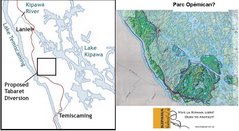
If Hydro Quebec is not actively pursuing Tabaret what is that bite out of Opemican for?
Kipawa Dam: After

Laniel Dam at 2006 Rally
Where is the Kipawa
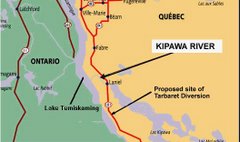
Kipawa flows into lake Temiskamingue, running from Kipawa Lake, under hwy 101 in Quebec
Kipawa Dam

laniel dam at 2004 River Rally
Tabaret is a Bad Idea
About the Kipawa
The best thing paddlers can do to help the cause of the Kipawa:
1. attend the rally and bring others including non paddlers to attend and buy beer and have fun
2. write your MP /MNA and raise the issue and post your objections -1 letter = 200 who didn't write
3. Write Thierry Vandal the CEO of Hydro Quebec strongly opposing the 132 MW standard decrying the use of "diversion" as the most environmentally inappropriate method of power production
4. Write Jean Charest, Premier of Quebec protesting that either the algonquin or the tabaret project will eliminate all other values on the Kipawa River by turning it into a dry gulch.
5. See if you can get other allied groups interested by showing your own interest, ie the Sierra Defense Fund, Earthwild, MEC, and so on.
6. Demand further consultation
7. Currently we are at the point where we need to sway public opinion and raise awareness.
However, if all else fails, don't get mad, simply disrupt, foment, and protest . The Monkey Wrench Gang.
Have you read Edward Abbey?
Important Addresses
CEO,Hydro Québec, 75 boul René Levesque, Montreal, P.Q., H2Z 1A4Caille.andre@hydro.qc.ca
The best thing paddlers can do to help the cause of the Kipawa:
1. attend the rally and bring others including non paddlers to attend and buy beer and have fun
2. write your MP /MNA and raise the issue and post your objections -1 letter = 200 who didn't write
3. Write Thierry Vandal the CEO of Hydro Quebec strongly opposing the 132 MW standard decrying the use of "diversion" as the most environmentally inappropriate method of power production
4. Write Jean Charest, Premier of Quebec protesting that either the algonquin or the tabaret project will eliminate all other values on the Kipawa River by turning it into a dry gulch.
5. See if you can get other allied groups interested by showing your own interest, ie the Sierra Defense Fund, Earthwild, MEC, and so on.
6. Demand further consultation
7. Currently we are at the point where we need to sway public opinion and raise awareness.
However, if all else fails, don't get mad, simply disrupt, foment, and protest . The Monkey Wrench Gang.
Have you read Edward Abbey?
Important Addresses
CEO,Hydro Québec, 75 boul René Levesque, Montreal, P.Q., H2Z 1A4Caille.andre@hydro.qc.ca
Tabaret is a Bad Idea (Part Two)
Les Amis de la Riviere Kipawa is poised to use an application to the Federal Court to issue a Writ of Mandamus to ensure the Minster does what he is supposed to do, protect the public's right to navigate the water control structure at Laniel, Quebec using the Navigable Waters Protection Act. (see http://www.kipawariver.ca/)
In the now gutted Navigable Waters Protection Act lay the means by which the Minister of Transport could keep the public right of passage down our great Canadian Heritage, our rivers and streams which are threatened especially by resource corporations and power brokers such as Hydro Quebec.
These powerful entities continue to petition that 'this' river or 'that' stream is not navigable and therefore not protectable.
I don't say that dams and bridges should not be built, only that if they are, historical navigation rights should be considered and preserved by making reasonable accommodations for recreational boaters.
It is the Minister of Transport, in exercising the right to allow or disallow work on or over a navigable waterway is what keeps boats and recreational boaters plying our waterways.
To many recent cases launched in the Federal Court concerning the Navigable Waters Protection Act, most recently the case of the Humber Environment Group of Cornerbrook Newfoundland versus the Cornerbrook Pulp and Paper Company indicates that the important oversight is not being faithfully performed. Have we really come to the point now where we must say "such and such a stream is one foot deep, possessing so many cubic feet per second flow and so on?" The answer to this is... YES!
The honourable Mr. Justice John A. O'Keefe, ruled that it had not been shown that the river was navigable. How convenient was that to the Minister? But either the Minister of Transport acts to protect our rivers and streams as a public right or he does not and that means rivers and streams currently enjoyed by kayakers and canoists.
Enough of the cheating, and double-talk. Canadians! our rivers and streams are our own, lets urge the Minister of Transport and the our government to protect them.
Peter Karwacki
In the now gutted Navigable Waters Protection Act lay the means by which the Minister of Transport could keep the public right of passage down our great Canadian Heritage, our rivers and streams which are threatened especially by resource corporations and power brokers such as Hydro Quebec.
These powerful entities continue to petition that 'this' river or 'that' stream is not navigable and therefore not protectable.
I don't say that dams and bridges should not be built, only that if they are, historical navigation rights should be considered and preserved by making reasonable accommodations for recreational boaters.
It is the Minister of Transport, in exercising the right to allow or disallow work on or over a navigable waterway is what keeps boats and recreational boaters plying our waterways.
To many recent cases launched in the Federal Court concerning the Navigable Waters Protection Act, most recently the case of the Humber Environment Group of Cornerbrook Newfoundland versus the Cornerbrook Pulp and Paper Company indicates that the important oversight is not being faithfully performed. Have we really come to the point now where we must say "such and such a stream is one foot deep, possessing so many cubic feet per second flow and so on?" The answer to this is... YES!
The honourable Mr. Justice John A. O'Keefe, ruled that it had not been shown that the river was navigable. How convenient was that to the Minister? But either the Minister of Transport acts to protect our rivers and streams as a public right or he does not and that means rivers and streams currently enjoyed by kayakers and canoists.
Enough of the cheating, and double-talk. Canadians! our rivers and streams are our own, lets urge the Minister of Transport and the our government to protect them.
Peter Karwacki
Tabaret is a Bad Idea (Part Three)
10 Reasons WhyTabaret is a Bad Idea1) Tabaret is too big. The station is designed to useevery drop of water available in the Kipawawatershed, but will run at only 44 percent capacity.We believe the Tabaret station is designed to usewater diverted from the Dumoine River into theKipawa watershed in the future.
2) The Tabaret project will eliminate the aquaticecosystem of the Kipawa River.The Tabaret project plan involves the diversion of a16-km section of the Kipawa River from its naturalstreambed into a new man-made outflow from LakeKipawa.
3) Tabaret will leave a large industrial footprint on thelandscape that will impact existing tourismoperations and eliminate future tourism potential.
4) The Tabaret project is an aggressive single-purposedevelopment, designed to maximize powergeneration at the expense of all other uses.
5) River-diversion, such as the Tabaret project, takinglarge amounts of water out of a river’s naturalstreambed and moving it to another place, is verydestructive to the natural environment.
6) The Kipawa River has been designated a protectedgreenspace in the region with severe limitations ondevelopment. This designation recognizes theecological, historical and natural heritage value ofthe river and the importance of protecting it.Tabaret will eliminate that value.
7) If necessary, there are other, smarter and morereasonable options for producing hydro power onthe Kipawa watershed. It is possible to build a lowimpactgenerating station on the Kipawa river, andmanage it as a “run-of-the-river” station, makinguse of natural flows while maintaining other values,with minimal impact on the environment.
8) The Kipawa watershed is a rich natural resource forthe Temiscaming Region, resonably close to largeurban areas, with huge untapped potential fortourism and recreation development in the future.Tabaret will severely reduce this potential.
9) Tabaret provides zero long-term economic benefitfor the region through employment. The plan is forthe station to be completely automated andremotely operated.
10) The Kipawa River is 12,000 years old. The riverwas here thousands of years before any peoplecame to the region. The Tabaret project will change all that.
Problems on a local River?
- There is more to do as well but you have to do your research and above all, don't give up.
- IN the meantime prepared a document itemizing the history of navigation of this spot and its recreational value. Use the Kipawa river history of navigation as a guide: see www.kipawariver.ca
- Under the Ministry of Environment guidelines you have a set period of time to petition the change under the environmental bill of rights, you may have limited time to take this action. But it involves going to court for a judicial review of the decision.
- 4. contact the ministry of natural resources officials and do the same thing.
- 3. contact the ministry of the environment and determine if they approved the project
- 2. determine if the dam was a legal dam, approved under the navigable waters protection act.
- 1. research the decision and timing of it to determine if an environmental assessment was done.
Minden Ontario
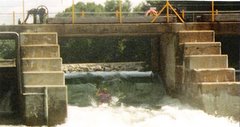
Gull River Water control at Horseshoe lake
A History of Navigation on the Kipawa River
Prior to the environmental assessment there was no signage at the Laniel Dam
T-Shirts Area: These are available now!

Send $25 and a stamped self addressed envelop for the Tshirt, and for the bumper sticker, a stamped and self addressed envelope with $5.00 for the bumper sticker to Les Amis de la rivière Kipawa, 80 Ontario St., Ottawa, Ontario, K1K 1K9 or click the link To purchase a Les Amis "T" contact Doug with the following information: Number of shirts:Sizes: Ship to Address: Method of Payment: cash, cheque and paypal, Shipto address:
Bumper Stickers Now Available

Get your bumper sticker and show your support for the Kipawa Legal Fund ! - send $5.00 in a Stamped, self addressed envelope to: Peter Karwacki Box 39111, Ottawa, Ontario, Canada, K1H 7X0




